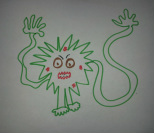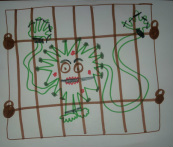What are Common Symptoms of Anxiety? An elementary aged child was asked to think about her anxious symptoms and worry thoughts and turn them into a cartoon character. This is what she created. Pretty scary stuff! Keep reading to see how this scary picture and others like it can be used in therapy to help children (and brave adults) gain power over their feelings and calm down the brain's limbic system. Eye Movement Desensitization and Reprocessing (EMDR), meditation and other modalities can help create calm as well. Anxiety looks very different from one person to the next. In some, it is an almost constant buzzing, in others it presents as sweaty, heart racing panic attacks. Some report not being able to enjoy social functions and others cry uncontrollably. Worry thoughts can be common as well as harmful debilitating self talk. Anxiety, no matter its form, is uncomfortable and something we see at The Center every day. Too Busy & Driven? Not Living Mindfully can be a Common Cause of AnxietyAnxiety can come from many different sources. Northern Virginia is a perfect breeding ground for anxiety. We work hard long hours alongside others who work just as hard. We are an intelligent population with intelligent, driven successful peers. Sometimes ambition, competition, and the comparisons we do to stay ahead and crisp, can keep us out of touch with ourselves and with what keeps us grounded. Not caring for oneself can be quickly depleting. Not measuring up or feeling "if I just did…" can leave one constantly looking ahead instead of being present and enjoying small moments in life. When we stop being present and are not choosing our life choices mindfully, we begin to feel an inner incongruence. This dissonance and inner conflict can manifest itself as anxiety. What are we Modeling for our Children? Anxiety and Your Child...Many of the children we see who struggle with anxiety seem to be wired for perfection or performance. Wanting to do it "right" or "perfect" can be a trait we teach our children silently. Our children have our genetic coding and predispositions, but they also watch us and learn how to navigate life and life choices without a word needing to be shared. Not all anxiety in children and adults is learned. Some feel vulnerable after a painful experience or trauma and channel the emotions into anxiety. Some experience a tremendous amount of worry thoughts that take up way too much brain space and begin to interfere with focus and daily happiness. The habit of internalizing negative experiences can lead to chronic anxiety and can be dangerous. Stopping it before it does real damage is the key. Infection Induced AnxietyWe do not just have ambition and drive in NOVA, we have ticks…and lots of them! Ticks carry more than Lyme Disease. Bartonella, Babesia and Mycoplasma are a few infections that can cause debilitating anxiety/depression and if left untreated can create significant neurological damage. Strep antibodies can also create panic and OCD in children and teens and in some cases, adults. This is known as PANDAS. When other agents create the anxiety, such as Chlamydia Pneumonia, it is referred to as PANS. When anxiety is intense and there does not seem to be a cause or known trigger, look to rule out infection as a potential influencer. Often physicians who present themselves as "Lyme Literate Doctors" are good specialist choices to visit. Diagnosing infection based anxiety is a process that relies on more information than blood tests alone. A thorough clinical assessment is highly recommended if you suspect infection based anxiety or panic. How to Cope with AnxietyThe first step in coping with anxiety is to understand its origin and to experience it for what it is. Sometimes people are quick to medicate anxiety without first exploring some of the above possibilities or going to the source itself to heal it. It is all too easy in our Northern Virginia culture to squelch the fires of anxiety by reaching for a beer or that second martini. Often screen time is used to melt away the feelings and distract the mind. Looking to the source can be painful, but useful. Is it Trauma? Fear? Are you losing touch with yourself and your loved ones? Could it be infection based? Look for the cause before reaching for a temporary fire extinguisher. When you know the cause, you can get assistance. If life is out of balance or you have unfinished emotional business to care for, therapy can help. If you need to find ways to calm your body and control your run away negative thoughts, counseling can help teach you these methods. Learning to listen to your negative self talk, turning it around and replacing it with healthy positive self talk can be empowering. Noticing how your body reacts to stress and emotional pain and what anxiety looks like in your body BEFORE it turns into panic can be an invaluable tool when learning to get ahead of panic attacks. Learning to take deep slow breaths to calm your heart and slow your thoughts can be key to reducing the symptoms of anxiety and decrease panic attacks. What Does Treatment for Anxiety Look Like?Adults can improve anxiety by learning the habits of Mindfulness and by practicing the tangible skills taught in Cognitive Behavioral Therapy (CBT). Our therapists are trained to help teach and monitor these skills. Sometimes, though the anxiety is embedded in trauma or is creating too much hyperarousal (extreme buzzing and almost non-stop physical symptoms) that CBT feels like putting a bandaid on a gushing wound. In cases like these, EMDR, Meditation/Visualizations, Art Therapy, Sand Tray or Play Therapy may be a better option to first calm the limbic system part of the brain so that the cognitive, more rational part of the brain can be accessed. Going to the cognitive brain first when someone is in a state of hyperarousal can be often be a mistake and can create frustration in the one suffering. Using methods such as relaxation, EMDR or Creative type therapies can calm the body and mind and help create a foundation for CBT skills to then root beneath. Our clinicians are trained in these modalities and can help from age 3 through adulthood. To request an appointment or for more information, click here. Creative Therapy Approaches One method to calm the limbic system and create empowerment over anxiety and other traumas is the use of a drawing series. Let's look back at the cartoon character above. In the series shown here, a young girl was asked to sit in the anxiety and create a cartoon character that embodied all of it. The next step is to have her get inside of herself and determine how she feels within her body and where she feels each emotion when she is within proximity of this creature (this is another picture not shown0. The third step is to make her face the anxiety and begin to feel empowered over it. She is now asked to do what ever she feels compelled to do to the character itself. This child chose to put her anxiety monster in jail (called encapsulation), lock up it's hands, feet and fingers, lock the jail in four places, gag it's mouth, soften it's prickliness and re-shape it's eye brows. We then check back in with the child to see how she is feeling. When children and adults are asked to approach their trauma or scariness head on and then learn to become empowered over it, the trauma/anxious feelings decrease and the empowerment increases. Some clients need to do more than one drawing series, while others choose another modality to continue to calm the limbic system. EMDR participants experience a similar experience as those who create via art. It seems to be about finding a safe way to revisit something uncomfortable…to sit with the scary and BE OKAY. I have had some adults brave enough to try this drawing series with great success. Please. Do not try a series like this without proper training. The series is intensive and involves more pictures and steps than what are shown here today. Gabrielle Anderson is the Director and a Therapist at the Family Therapy Center of Northern Virginia, llc She and the other team members can be contacted directly from the Center's Meet the Team page.
0 Comments
Leave a Reply. |
AuthorThese blog entries are written by our very own clinicians. When inspiration hits, another entry will be logged. Get Blog UpdatesWhat is an RSS FEEDER? If you click on the RSS Feeder, anytime a new blog entry is added to the website, you will be automatically notified of it. The only thing you need to do is get an RSS READER app. Chances are, if you click on the RSS Feeder, and you do not have a reader, it will take you directly to the app store so you can install one. It takes 60 seconds to get set up for auto notifications of new blogs sent directly to you!
Archives
May 2021
Categories
All
|
 RSS Feed
RSS Feed